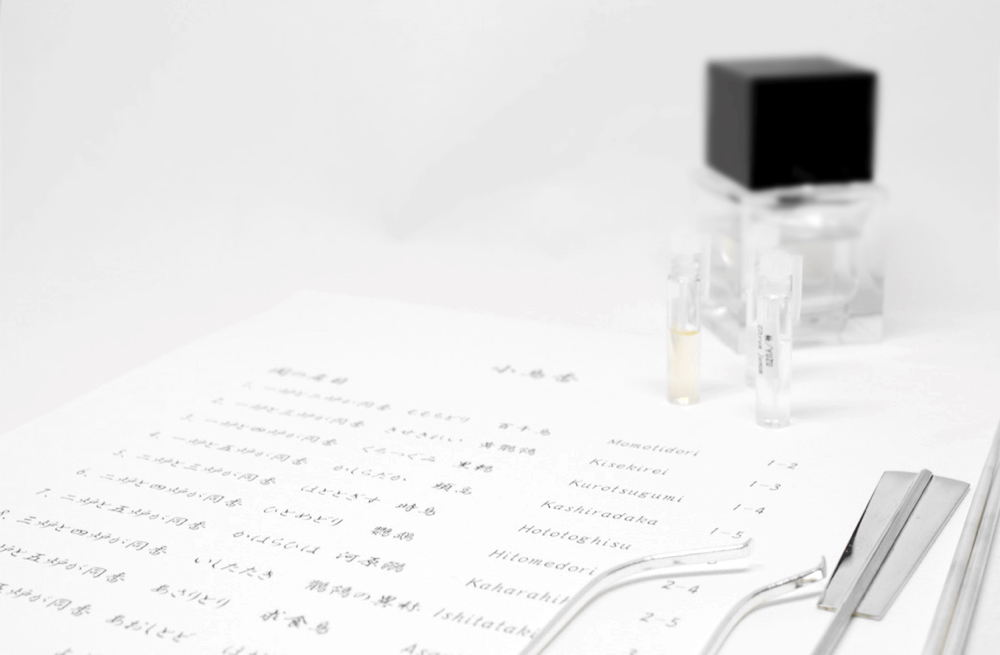Scent workshop by DI SER
Vol. 1 Scent Explore by DI SER
Tuesday 17. July. 2018
13:00 - 17:00
First half
Introducing of basics of scent - how to express and remember it.
Used scent: Geranium, Yuzu Green, Yuzu, Lavender, Hamanasu, Shiso
Tea break - served with Gyokuro tea
Second half
Introducing of Japanese incense ceremony and how to play with scent
First half time was used to train our olfaction to remember and express scents. Scents can be expressed by anything, a color, a sound, an image, a word etc.. We wrote down whatever we felt. There is no right and wrong to express a scent and it's individual.
Single scent consists of more than 500 different components. In nature, flowers and plants are communicating always with scent, as calling bees or alarming against insects. We, human, also distinguish scents in each occasion, to appeal to other people, to meditate, or to keep away from insects, for example.
After the first half time, our noses became already full of scent and we couldn't smell anything any further. So it was time for a tea break. Yasu brought one of best Gyokuro tea from Fukuoka and his special Gyokuro tea serving set. For Gyokuro, the water temperature must be 40 - 50 degree and served in tiny tea cups (actually the best quantity to enjoy Gyokuro is only 15 drops). The taste is almost like Dashi, Japanese broth. No bitter at all and rather subtle sweet. It is perfect refreshing for our brain and olfaction.
In second half time, we learned how to play with scent. Formal Japanese scent ceremony is full of complexity, needing real Agarwoods, different sort of tools, and special coal burner. Besides, Agarwood is strictly preserved and under control of an international organisation to avoid an excessive trading. On top of it, to enjoy traditional Japanese scent ceremony, we must all have knowledge about Japanese classic literature, song, and poems from the 7-8 century, because a theme in each play is often taken from them in these era. Therefore, we created a simplified version of Japanese scent ceremony with perfumes instead of Agarwood, in order to enjoy it casually. We also simplified the some rules to bring this formal tradition to closer to us which is used to be enjoyed only by nobles.
Kotori-ko
This play is named after small birds. Kotori means a small bird. Ko means scent. The host prepares twice of five different scent. One scent from each group is picked and exchanged into the other group, which means, two scents out of five should be same. The Guests listen to five scents and answer which ones are same. It can be there is no pair, if at the beginning the host picked same scents from each group.
Genji-ko
This play is named after one of oldest classic literature, Hikaru Genji Monogatari. The host prepares five times of five different scent, in total twenty-five. Five out of these are picked randomly and the guests listen to these five to find out which ones are same. There are fifty-two possible combinations that are shown in the five-line illustration, Genji-ko no Zu, and the guests must find one right combination and answer with the name of chapter of the story in Genji-ko no Zu. Traditionally Genji-ko no Zu is counted from right to left. For example, No. 26 shows 1st, 2nd, and 3rd are same. No. 27 shows 2nd and 4th are same.
At end, it became such an unforgettable afternoon for all of us, not only by leaning but also with a lot of fun and laughing. This workshop brought us a world where we immerged in scent with such a positive atmosphere. It was the power of scent and Yasu's passion toward scent.



